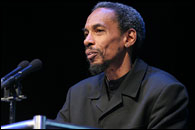may the ancestors be pleased
“ Amon is represented in various forms: (1) As an ape; (2) as a lion resting with head erect, like the primitive earth lion Aker; (3) as a frog-headed man accompanied by Ament, his serpent-headed female counterpart; (4) as a serpent-headed man, while his consort is cat-headed; (5) as a man god with the royal sceptre in one hand and the symbol of life (ankh) in the other; (6) as a ram-headed man.
In the Twelfth Dynasty a small temple was erected to Amon in the northern part of the city which was called Apet, after the mother goddess of that name who ultimately was fused with Hathor. "
Amon, the ram god, was the most famous oracle in
The oracle of Amon achieved great renown. The god was consulted by warriors, who were duly promised victory and great spoils. Wrongdoers were identified by the god, and he was even consulted regarding the affairs of State. Ultimately his priests achieved great influence owing to their reputation as foretellers of future events, who made known the will of the god. A good deal of trickery was evidently indulged in, for we gather that the god signified his assent to an expressed wish by nodding his head, or selected a suitable leader of men by extending his arm.
Amon was fused with several deities as his various animal forms indicate. The ram's head comes, of course, from Min, and it is possible that the frog's head was from Hekt. His cult also appropriated the war god Mentu, who is depicted as a bull. Mentu, however, continued to have a separate existence, owing to his fusion with Horus. He appears in human form wearing a bull's tall with the head of a hawk, which is surmounted by a sun disk between Amon's double plumes; he is also depicted as a hawk-headed sphinx. As a bull-headed man he carries bow and arrows, a club, and a knife.
In his Horus form Mentu stands on the prow of the sun bark on the nightly journey through Duat, and slays the demons with his lance. He was appropriated, of course, by the priests of
Amon was linked with the great sun god in the Eleventh Dynasty, and as Amon-ra he ultimately rose to the supreme position of national god, while his cult became the most powerful in
Amon's wife was Mut, whose name signifies "the mother", and she may be identical with Apet. She was "queen of the gods" and "lady of the sky". Like Nut,
The moon god Khonsu was at
As a lunar deity Khonsu caused the crops to spring up and ripen. He was also the Egyptian Cupid, who touched the hearts of lads and girls with love. The Oracle of Khonsu was consulted by those who prayed for offspring. Agriculturists lauded the deity for increasing their flocks and herds.
This popular god also gave "the air of life" to the newly born, arid was thus a wind god like Her-shef and Khnûmû. As ward of the atmosphere he exercised control over the evil spirits which caused the various diseases and took possession of human beings, rendering them epileptic or insane. Patients were cured by Khonsu, "giver of oracles", whose fame extended beyond the bounds of



0 Comments:
Post a Comment
<< Home